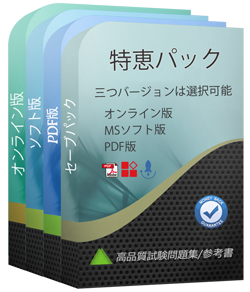70-595試験学習資料を開発する専業チーム
私たちは70-595試験認定分野でよく知られる会社として、プロのチームにTS: Developing Business Process and Integration Solutions by Using Microsoft BizTalk Server 2010試験復習問題の研究と開発に専念する多くの専門家があります。したがって、我々のTS試験学習資料が70-595試験の一流復習資料であることを保証することができます。私たちは、TS 70-595試験サンプル問題の研究に約10年間集中して、候補者が70-595試験に合格するという目標を決して変更しません。私たちの70-595試験学習資料の質は、Microsoft専門家の努力によって保証されています。それで、あなたは弊社を信じて、我々のTS: Developing Business Process and Integration Solutions by Using Microsoft BizTalk Server 2010最新テスト問題集を選んでいます。
TS: Developing Business Process and Integration Solutions by Using Microsoft BizTalk Server 2010試験学習資料での高い復習効率
ほとんどの候補者にとって、特にオフィスワーカー、70-595試験の準備は、多くの時間とエネルギーを必要とする難しい作業です。だから、適切な70-595試験資料を選択することは、70-595試験にうまく合格するのに重要です。高い正確率がある70-595有効学習資料によって、候補者はTS: Developing Business Process and Integration Solutions by Using Microsoft BizTalk Server 2010試験のキーポイントを捉え、試験の内容を熟知します。あなたは約2日の時間をかけて我々の70-595試験学習資料を練習し、70-595試験に簡単でパスします。
無料デモをごダウンロードいただけます
様々な復習資料が市場に出ていることから、多くの候補者は、どの資料が適切かを知りません。この状況を考慮に入れて、私たちはMicrosoft 70-595の無料ダウンロードデモを候補者に提供します。弊社のウェブサイトにアクセスしてTS: Developing Business Process and Integration Solutions by Using Microsoft BizTalk Server 2010デモをダウンロードするだけで、70-595試験復習問題を購入するかどうかを判断するのに役立ちます。多数の新旧の顧客の訪問が当社の能力を証明しています。私たちの70-595試験の学習教材は、私たちの市場におけるファーストクラスのものであり、あなたにとっても良い選択だと確信しています。
70-595試験認定を取られるメリット
ほとんどの企業では従業員が専門試験の認定資格を取得する必要があるため、70-595試験の認定資格がどれほど重要であるかわかります。テストに合格すれば、昇進のチャンスとより高い給料を得ることができます。あなたのプロフェッショナルな能力が権威によって認められると、それはあなたが急速に発展している情報技術に優れていることを意味し、上司や大学から注目を受けます。より明るい未来とより良い生活のために私たちの信頼性の高い70-595最新試験問題集を選択しましょう。
Tech4Examはどんな学習資料を提供していますか?
現代技術は人々の生活と働きの仕方を革新します(70-595試験学習資料)。 広く普及しているオンラインシステムとプラットフォームは最近の現象となり、IT業界は最も見通しがある業界(70-595試験認定)となっています。 企業や機関では、候補者に優れた教育の背景が必要であるという事実にもかかわらず、プロフェッショナル認定のようなその他の要件があります。それを考慮すると、適切なMicrosoft TS: Developing Business Process and Integration Solutions by Using Microsoft BizTalk Server 2010試験認定は候補者が高給と昇進を得られるのを助けます。
Microsoft TS: Developing Business Process and Integration Solutions by Using Microsoft BizTalk Server 2010 認定 70-595 試験問題:
1. A BizTalk Server 2010 orchestration calls a Business Rules Engine policy. This policy evaluates test scores to determine whether a candidate passes or fails. The BizTalk solution and the policy are deployed. Business users have decided that the value of a passing score should be raised from 60% to 70%. You need to adjust the policy to reflect the modified rule parameter. What should you do?
A) Open the policy in the Business Rules Composer and create a different policy with a new name. Then copy the currently deployed version to the new policy and modify to reflect the changed parameter. Deploy the new policy.
B) Create a new vocabulary in the Business Rules Composer. Add the new parameter to this vocabulary and then publish the vocabulary.
C) Open the policy in the Business Rules Composer. Create a new version of the policy and edit this version to reflect the changed parameter. Then publish the new version.
D) Open the policy in the Business Rules Composer. Create a new version of the policy and edit this version to reflect the changed parameter. Then deploy the new version.
2. You are developing applications for BizTalk Server 2010. The application processes orders for two vendors. These vendors have different message formats for their orders. You define BizTalk schemas for both vendors in separate projects and name the projects VendorA and VendorB. You promote the OrderType property in the schema of VendorA and the PurchaseType property in the schema of VendorB.
Then you deploy the application. You need to log messages to disk for shoe orders for VendorA and bike orders for VendorB. What should you do?
A) Add a send port group with the filter: VendorA.OrderType==Shoes Or VendorB.PurchaseType==Bikes
B) PurchaseType==Bikes Add a FILE send port with the filter: VendorA.OrderType==Shoes Or VendorPurchaseType==Bikes
C) Add a FILE send port with the filter: VendorOrderType==Shoes OR VendorB.PurchaseType==Bikes
D) Add a send port group with the filter: VendorA.OrderType==Shoes And VendorB.PurchaseType==Bikes
3. You send data to a Microsoft Windows Communication Foundation (WCF) service from a BizTalk Server 2010 application. You generate supporting artifacts for calling the service from Microsoft Visual Studio by using the Consume WCF Service wizard. You modify the names used in the orchestration to SendWCFPort for the port and to TransmitData for the port operation. In the orchestration, you set the context property BTS.Operation to the operation name. You deploy the BizTalk projects and import the generated binding file to create the send port. You need to configure the SOAP action header for the send port that calls the WCF service. Which operation should be specified in the SOAP action header XML?
A) SendWCFPort\SendData
B) TransmitData
C) SendWCFPort\TransmitData
D) SendData
4. A BizTalk Server 2010 solution uses an orchestration to send XML documents to various vendors. The XML documents are delivered by an FTP port. The port is configured in the orchestration with the Binding property set to Specify later. You need to ensure that the FTP address of the send port can be specified in the orchestration at run time. What should you do?
A) Create a new send port group. Add a new FTP send port to the send port group for each vendor. Bind the orchestration to this send port group.
B) Configure the Binding property for the port in the orchestration to Dynamic. Set the value of the Microsoft.XLANGs.BaseTypes.Address property for this port in the orchestration to the appropriate vendor address.
C) Configure the Binding property for the port in the orchestration to Specify now. Bind the orchestration to this new port. Set the value of the Microsoft.XLANGs.BaseTypes.Address property for this port in the orchestration to the appropriate vendor address.
D) Configure the Binding property for the port in the orchestration to Direct. Set the value of the Microsoft. XLANGs.Core.PortBinding property for this port in the orchestration to the appropriate vendor address.
5. A BizTalk Server 2010 solution contains multiple applications. One of the applications sends EDI messages to trading partners. The trading partners are defined as parties in the BizTalk Administration console. You need to extract the binding and party information for only the EDI application in an XML file so that you can store that information in source code control. What should you do?
A) Create a binding file for the EDI application and include the party information.
B) Create a binding file for one of the assemblies in the EDI application.
C) Create a Microsoft Windows Installer (MSI) file for the EDI application and include the party information.
D) Create a binding file that contains the binding for the BizTalk group.
質問と回答:
| 質問 # 1 正解: D | 質問 # 2 正解: C | 質問 # 3 正解: B | 質問 # 4 正解: B | 質問 # 5 正解: A |


 弊社は製品に自信を持っており、面倒な製品を提供していません。
弊社は製品に自信を持っており、面倒な製品を提供していません。


 Fujii
Fujii


